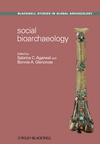At a moment when tensions within anthropology are still simmering close to the surface, Sabrina Agarwal's and Bonnie Glencross' edited collection of social bioarchaeological essays highlight the importance of collaborative efforts within the discipline. The volume is definitely not light reading, however, it represents a carefully curated exhibit on the development of biological archaeology and traces its relevance to current research.
The volume is divided into three sections that respectively deal with definition and development, traditional practices, and application within cultural and social contexts. The opening discussion walks readers through the shift in biological anthropology to a more cultural/social friendly approach, making note of landmark studies. In the early 19th- and 20th-centuries, biological anthropology emphasized, well, biology. The field was dominated by biomedically trained researchers who spent little time investigating culture or history connected to the skeletons that they had made their work. It was not until 1950s that the biocultural approach began to gain a foothold. Washburn's (1951) publication titled "New Physical Anthropology" was instrumental to the shift:
These papers proposed a revolutionary, strategic redirection from the existing model, which Washburn considered to be driven by anthropometry and speculation. Instead, the New Anthropology would be characterized by synthetic theory-driven research and motivated by hypothesis testing premised on models of evolution and adaptation (17).
In addition to Washburn's publication, several other notable studies were released, including Neumann's (1952) "Archaeology and Race in the American Indian," which provided methods for examining and reconstructing cultural history in relation cranial morphology. Within archaeology, researchers began to note the influence of long held external factors, such as the environment (e.g., Livingstone 1958), in population growth and political, economic, and social strategies. Lest readers think that the march toward biocultural approaches was inevitable, the authors highlight resistance within the subdiscipline to accept processual perspectives. However, it seems that shifts in research questions themselves (e.g., mobility and agricultural patterns, sexual and gendered divisions of labor, effects of undernutrition on skeletal morphology) warranted cultural and historical analyses to provide contextual support.
A great example of the social bioarchaeological approach can be found in the chapter titled "Life Histories of Enslaved Africans in Colonial New York." This discussion explores childhood health within the population interred at the New York African Burial Ground, asking:
- What was the significance of the ages of 6, 9, or 11 for enslaved children in colonial New York (typical ages of sale for slaves)?
- Were these ages significant within the population?
- What developmental conditions or experiences of childhood can be extracted?
The discussion explores the increased rate of dental hypoplasia through a historical and social lens that illuminates the social and environmental impact on the body.
Social Bioarchaeology makes an excellent reference for this subfield, and stresses the importance of a multi-disciplinary approach at a time perhaps when anthropology needs it most.
Social Bioarchaeology | Sabrina C. Agarwal and Bonnie A. Glencross, eds. | Wiley Blackwell | 496 pages | $99.95 (Softcover)
--
Note: Review copy provided by the publisher.


I'm jealous. I really want to read this, but it's expensive. Wish I could get publishers to give me free books (well, free books related to my research rather than to my teaching). Guess I'll go get it from the library. :)
ReplyDelete